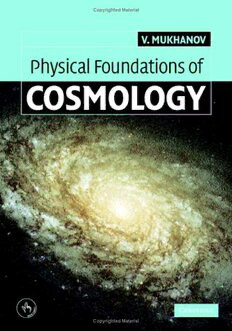
Physical foundations of cosmology PDF
Preview Physical foundations of cosmology
PHYSICAL FOUNDATIONS OF COSMOLOGY Inflationarycosmologyhasbeendevelopedoverthelast20yearstoremedyserious shortcomingsinthestandardhotbigbangmodeloftheuniverse.Takinganoriginal approach,thistextbookexplainsthebasisofmoderncosmologyandshowswhere thetheoreticalresultscomefrom. The book is divided into two parts: the first deals with the homogeneous and isotropicmodeloftheuniverse,whilethesecondpartdiscusseshowinitialinhomo- geneitiescanexplaintheobservedstructureoftheuniverse.Analyticaltreatments of traditionally highly numerical topics – such as primordial nucleosynthesis, re- combination and cosmic microwave background anisotropy – are provided, and inflation and quantum cosmological perturbation theory are covered in great de- tail.Thereaderisbroughttothefrontiersofcurrentcosmologicalresearchbythe discussionofmorespeculativeideas. Thisisanidealtextbookbothforadvancedstudentsofphysicsandastrophysics and for those with a particular interest in theoretical cosmology. Nearly every formulainthebookisderivedfrombasicphysicalprinciplescoveredinundergrad- uatecourses.Eachchapterincludesallnecessarybackgroundmaterialandnoprior knowledgeofgeneralrelativityandquantumfieldtheoryisassumed. Viatcheslav Mukhanov is Professor of Physics and Head of the As- troparticlePhysicsandCosmologyGroupattheDepartmentofPhysics,Ludwig- Maximilians-Universita¨tMu¨nchen,Germany.FollowinghisPh.D.attheMoscow Physical-Technical Institute, he conducted research at the Institute for Nuclear Research, Moscow, between 1982 and 1991. From 1992, he was a lecturer at Eidgeno¨ssischeTechnischeHochschule(ETH)inZu¨rich,Switzerland,untilhisap- pointmentatLMUin1997.Hiscurrentresearchinterestsincludecosmicmicrowave background fluctuations, inflationary models, string cosmology, the cosmological constant problem, dark energy, quantum and classical black holes, and quantum cosmology. He also serves on the editorial boards of leading research journals in theseareas. In 1980–81, Professor Mukhanov and G. Chibisov discovered that quantum fluctuationscouldberesponsibleforthelarge-scalestructureoftheuniverse.They calculated the spectrum of fluctuations in a model with a quasi-exponential stage of expansion, later known as inflation. The predicted perturbation spectrum is in very good agreement with measurements of the cosmic microwave background fluctuations. Subsequently, Professor Mukhanov developed the quantum theory ofcosmologicalperturbationsforcalculatingperturbationsingenericinflationary models.In1988,hewasawardedtheGoldMedaloftheAcademyofSciencesof theUSSRforhisworkonthistheory. PHYSICAL FOUNDATIONS OF COSMOLOGY VIATCHESLAV MUKHANOV Ludwig-Maximilians-Universita¨tMu¨nchen cambridge university press Cambridge, New York, Melbourne, Madrid, Cape Town, Singapore, São Paulo Cambridge University Press TheEdinburghBuilding,Cambridgecb22ru,UK Published in the United States of America by Cambridge University Press, New York www.cambridge.org Information on this title: www.cambridge.org/9780521563987 © V. Mukhanov 2005 Thispublicationisincopyright.Subjecttostatutoryexceptionandtotheprovisionof relevantcollectivelicensingagreements,noreproductionofanypartmaytakeplace withoutthewrittenpermissionofCambridgeUniversityPress. Firstpublishedinprintformat 2005 isbn-13 978-0-511-13679-5 eBook (NetLibrary) isbn-10 0-511-13679-x eBook (NetLibrary) isbn-13 978-0-521-56398-7 hardback isbn-10 0-521-56398-4 hardback CambridgeUniversityPresshasnoresponsibilityforthepersistenceoraccuracyofurls forexternalorthird-partyinternetwebsitesreferredtointhispublication,anddoesnot guaranteethatanycontentonsuchwebsitesis,orwillremain,accurateorappropriate. Contents ForewordbyProfessorAndreiLindepage xi Preface xiv Acknowledgements xvi Unitsandconventions xvii PartIHomogeneousisotropicuniverse 1 1Kinematicsanddynamicsofanexpandinguniverse 3 1.1 Hubblelaw 4 1.2 DynamicsofdustinNewtoniancosmology 8 1.2.1 Continuityequation 9 1.2.2 Accelerationequation 9 1.2.3 Newtoniansolutions 10 1.3 FromNewtoniantorelativisticcosmology 13 1.3.1 Geometryofanhomogeneous,isotropicspace 14 1.3.2 TheEinsteinequationsandcosmicevolution 19 1.3.3 Friedmannequations 22 1.3.4 Conformaltimeandrelativisticsolutions 24 1.3.5 Milneuniverse 27 1.3.6DeSitteruniverse 29 2 Propagationoflightandhorizons 37 2.1Lightgeodesics 37 2.2 Horizons 38 2.3 Conformaldiagrams 41 2.4 Redshift 55 2.4.1 Redshiftasameasureoftimeanddistance 58 2.5Kinematictests 60 2.5.1Angulardiameter–redshiftrelation 60 2.5.2Luminosity–redshiftrelation 64 v vi Contents 2.5.3 Numbercounts 66 2.5.4 Redshiftevolution 67 3 Thehotuniverse 69 3.1 Thecompositionoftheuniverse 69 3.2 Briefthermalhistory 72 3.3 Rudimentsofthermodynamics 74 3.3.1 Maximalentropystate,thermalspectrum, conservationlawsandchemicalpotentials 75 3.3.2 Energydensity,pressureandtheequationofstate 79 3.3.3 Calculatingintegrals 82 3.3.4 Ultra-relativisticparticles 85 3.3.5 Nonrelativisticparticles 88 3.4 Leptonera 89 3.4.1 Chemicalpotentials 92 3.4.2 Neutrinodecouplingandelectron–positronannihilation 94 3.5 Nucleosynthesis 97 3.5.1 Freeze-outofneutrons 98 3.5.2 “Deuteriumbottleneck” 104 3.5.3 Helium-4 108 3.5.4 Deuterium 112 3.5.5 Theotherlightelements 117 3.6 Recombination 120 3.6.1 Heliumrecombination 120 3.6.2 Hydrogenrecombination:equilibriumconsideration 122 3.6.3 Hydrogenrecombination:thekineticapproach 123 4 Theveryearlyuniverse 131 4.1 Basics 132 4.1.1 Localgaugeinvariance 133 4.1.2 Non-Abeliangaugetheories 135 4.2 Quantumchromodynamicsandquark–gluonplasma 138 4.2.1 Runningcouplingconstantandasymptoticfreedom 141 4.2.2 Cosmologicalquark–gluonphasetransition 146 4.3 Electroweaktheory 150 4.3.1 Fermioncontent 151 4.3.2 “Spontaneousbreaking”ofU(1)symmetry 153 4.3.3 Gaugebosons 154 4.3.4 Fermioninteractions 158 4.3.5 Fermionmasses 160 4.3.6 CPviolation 162 Contents vii 4.4 “Symmetryrestoration”andphasetransitions 165 4.4.1 Effectivepotential 165 4.4.2 U(1)model 170 4.4.3 Symmetryrestorationathightemperature 173 4.4.4 Phasetransitions 174 4.4.5 Electroweakphasetransition 176 4.5 Instantons,sphaleronsandtheearlyuniverse 180 4.5.1 Particleescapefromapotentialwell 180 4.5.2 Decayofthemetastablevacuum 184 4.5.3 Thevacuumstructureofgaugetheories 190 4.5.4 Chiralanomalyandnonconservationofthe fermionnumber 196 4.6 BeyondtheStandardModel 199 4.6.1 Darkmattercandidates 203 4.6.2 Baryogenesis 210 4.6.3 Topologicaldefects 216 5 InflationI:homogeneouslimit 226 5.1 Problemofinitialconditions 226 5.2 Inflation:mainidea 229 5.3 Howcangravitybecome“repulsive”? 233 5.4 Howtorealizetheequationofstate p ≈ −ε 235 5.4.1 Simpleexample: V = 1m2ϕ2. 236 2 5.4.2 Generalpotential:slow-rollapproximation 241 5.5 Preheatingandreheating 243 5.5.1 Elementarytheory 244 5.5.2 Narrowresonance 245 5.5.3 Broadresonance 249 5.5.4 Implications 255 5.6 “Menu”ofscenarios 256 PartII Inhomogeneousuniverse 263 6 GravitationalinstabilityinNewtoniantheory 265 6.1 Basicequations 266 6.2 Jeanstheory 267 6.2.1 Adiabaticperturbations 269 6.2.2 Vectorperturbations 270 6.2.3 Entropyperturbations 270 6.3 Instabilityinanexpandinguniverse 271 6.3.1 Adiabaticperturbations 273 6.3.2 Vectorperturbations 275 viii Contents 6.3.3 Self-similarsolution 275 6.3.4 Coldmatterinthepresenceofradiationordarkenergy 276 6.4 Beyondlinearapproximation 279 6.4.1 Tolmansolution 281 6.4.2 Zel’dovichsolution 283 6.4.3 Cosmicweb 286 7 GravitationalinstabilityinGeneralRelativity 289 7.1 Perturbationsandgauge-invariantvariables 290 7.1.1 Classificationofperturbations 291 7.1.2 Gaugetransformationsandgauge-invariantvariables 292 7.1.3 Coordinatesystems 295 7.2 Equationsforcosmologicalperturbations 297 7.3 Hydrodynamicalperturbations 299 7.3.1 Scalarperturbations 299 7.3.2 Vectorandtensorperturbations 309 7.4 Baryon–radiationplasmaandcolddarkmatter 310 7.4.1 Equations 311 7.4.2 Evolutionofperturbationsandtransferfunctions 314 8 InflationII:originoftheprimordialinhomogeneities 322 8.1 Characterizingperturbations 323 8.2 Perturbationsoninflation(slow-rollapproximation) 325 8.2.1 InsidetheHubblescale 327 8.2.2 Thespectrumofgeneratedperturbations 329 8.2.3 Whydoweneedinflation? 332 8.3 Quantumcosmologicalperturbations 334 8.3.1 Equations 335 8.3.2 Classicalsolutions 337 8.3.3 Quantizingperturbations 340 8.4 Gravitationalwavesfrominflation 348 8.5 Self-reproductionoftheuniverse 352 8.6 Inflationasatheorywithpredictivepower 354 9 Cosmicmicrowavebackgroundanisotropies 356 9.1 Basics 357 9.2 Sachs–Wolfeeffect 360 9.3 Initialconditions 363 9.4 Correlationfunctionandmultipoles 365 9.5 Anisotropiesonlargeangularscales 367 9.6 Delayedrecombinationandthefinitethicknesseffect 369 9.7 Anisotropiesonsmallangularscales 374 9.7.1 Transferfunctions 374 Contents ix 9.7.2 Multipolemoments 377 9.7.3 Parameters 379 9.7.4 Calculatingthespectrum 382 9.8 Determiningcosmicparameters 385 9.9 Gravitationalwaves 391 9.10 Polarizationofthecosmicmicrowavebackground 395 9.10.1 Polarizationtensor 396 9.10.2 Thomsonscatteringandpolarization 398 9.10.3 Delayedrecombinationandpolarization 400 9.10.4 E and B polarizationmodesandcorrelationfunctions 402 9.11 Reionization 407 Bibliography 410 Expandinguniverse(Chapters1and2) 410 Hotuniverseandnucleosynthesis(Chapter3) 411 Particlephysicsandearlyuniverse(Chapter4) 412 Inflation(Chapters5and8) 414 Gravitationalinstability(Chapters6and7) 416 CMBfluctuations(Chapter9) 417 Index 419
